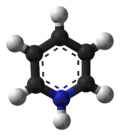
Back پیریدینیوم AZB Pyridinium Czech Piridinio Spanish پیریدینیوم Persian Pyridinium French ピリジニウム Japanese Pyridinium Dutch Piridinijum Serbo-Croatian Pyridínium Slovak Piridinijum Serbian
| |||
| Names | |||
|---|---|---|---|
| Preferred IUPAC name
Pyridin-1-ium | |||
| Identifiers | |||
3D model (JSmol)
|
|||
| ChemSpider | |||
PubChem CID
|
|||
| UNII | |||
CompTox Dashboard (EPA)
|
|||
| |||
| |||
| Properties | |||
| [C5H5NH]+ | |||
| Molar mass | 80.110 g·mol−1 | ||
| Acidity (pKa) | ~5 [1][2] | ||
| Conjugate base | Pyridine | ||
Except where otherwise noted, data are given for materials in their standard state (at 25 °C [77 °F], 100 kPa).
| |||
Pyridinium refers to the cation [C5H5NH]+. It is the conjugate acid of pyridine. Many related cations are known involving substituted pyridines, e.g. picolines, lutidines, collidines. They are prepared by treating pyridine with acids.[3]
As pyridine is often used as an organic base in chemical reactions, pyridinium salts are produced in many acid-base reactions. Its salts are often insoluble in the organic solvent, so precipitation of the pyridinium leaving group complex is an indication of the progress of the reaction.
Pyridinium cations are aromatic, as determined through Hückel's rule.[4] They are isoelectronic with benzene.
- ^ Linnell, Robert (1960). "Notes – Dissociation Constants of 2-Substituted Pyridines". Journal of Organic Chemistry. 25 (2): 290. doi:10.1021/jo01072a623.
- ^ Pearson, Ralph G.; Williams, Forrest V. (1953). "Rates of Ionization of Pseudo Acids.1V. Steric Effects in the Base-catalyzed Ionization of Nitroethane". Journal of the American Chemical Society. 75 (13): 3073. doi:10.1021/ja01109a008.
- ^ George A. Olah; Michael Watkins (1978). "Fluorinations With Pyridinium Polyhydrogen Fluoride Reagent: 1-Fluoroadamantane". Org. Synth. 58: 75. doi:10.15227/orgsyn.058.0075.
- ^ "Aromatic Compounds" (PDF). Alex Roche, Rutgers University.
© MMXXIII Rich X Search. We shall prevail. All rights reserved. Rich X Search

